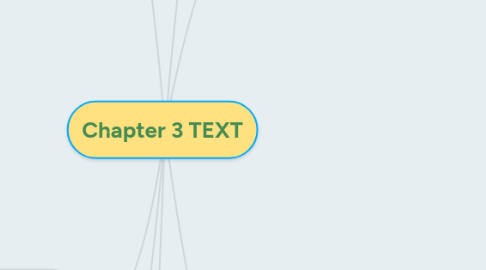
1. Bitmap font and vector font
1.1. Bitmap
1.1.1. Bitmaps font consist of a matrix of dots or pixels representing the image. -File size increases as more sizes are added. -Require a lot of memory. -Non-scalable
1.2. Vector
1.2.1. Vector fonts drawing use instructions and mathematical formulae to describe each glyph. -can draw any size by scaling the vector drawing primitives mathematically -File size is much smaller than bitmaps. -TrueType, OpenType and PostScript are vector font formats.
2. Character sets
2.1. Computers can only understand numbers, so an ASCII (American Standard Code for Information Interchange) code is the numerical representation of a character. Each character is represented by a unique 7-bit binary code word, meaning that there are 128 (27) alternative characters
3. Font editing and design tools
3.1. Fontographer Fontographer is a specialized graphics editor. It is compatible with both Macintosh and Windows platforms. It can be used to develop PostScript, TrueType, and OpenType fonts. It can also modify existing typefaces and incorporate PostScript artwork
4. Hypertext and hypermedia
4.1. A hypertext or hypermedia system enables the user to navigate through text in a nonlinear way.
4.2. Hypertext
4.2.1. -Hypertext is a text which contains links to other texts. -The term was invented by Ted Nelson around 1965. -Hypertext is the subset of hypermedia.
4.2.2. used for: -Electronic publishing and reference works -Technical documentation -Educational courseware -Interactive kiosks -Electronic catalogs
4.3. Hypermedia
4.3.1. -Hypermedia is not constrained to be text-based. -It can include other media, e.g., graphics, images, and especially the continuous media – sound and video.
4.3.2. Hypermedia structures
4.3.2.1. 1.Links ~Links are connections between conceptual elements. ~Links are the navigation pathways and menus.
4.3.2.2. 2.Nodes ~Nodes are accessible topics, documents, messages, and content elements. ~Nodes and links form the backbone of a knowledge access system.
4.3.2.3. 3.Anchors ~An anchor is defined as the reference from one document to another document, image, sound, or file on the Web.
5. Importance of text in a multimedia presentation
5.1. Text is obviously the simplest of data types and requires the least amount of storage.
5.2. Text in the form of symbols, words, sentences, and paragraphs.
5.3. Text is a vital element of multimedia menus, navigation systems, and content
6. Understanding fonts and typefaces
6.1. A typeface is a family of graphic characters, often with many type sizes and styles.
6.2. A font is a collection of characters of a single size and style belonging to a particular typeface family.
6.3. The study of fonts and typefaces includes the following
6.3.1. 1.Font styles include: -Boldface -Italic -Underlining -Outlining
6.3.2. 2.Font Terminology -Baseline – the line on which the bases of characters are arranged -Cap height - cap height refers to the height of a capital letter -x-height – the distance between the baseline and the top of a lower-case letter x -Ascenders/descenders – strokes that rise above the x-height/drop below the baseline -Kerning – adjustment of space between certain pairs of letters (e.g. AV) to make them look more uniform -Tracking - adjustment of space for groups of letters
6.3.2.1. 3.Cases -A capitalized letter is referred to as uppercase, while a small letter is referred to as lowercase. -Placing an uppercase letter in the middle of a word is referred to as an intercap or CamelCase
